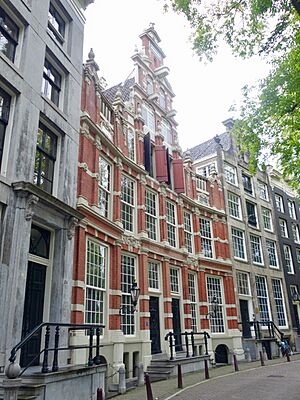Ludolf Bakhuizen facts for kids
Ludolf Bakhuizen (born in Germany, 1630 or 1632 – died 1708) was a famous Dutch artist. He was a painter, a draughtsman (someone who draws), a calligrapher (someone who writes beautifully), and a printmaker. He became the most important Dutch painter of sea scenes after two other famous artists, Willem van de Velde the Elder and Younger, moved to England in 1672. Ludolf also painted pictures of his family and friends.
Contents
Life of a Sea Painter
Ludolf Bakhuizen was born in Emden, a town in Germany. Around 1650, when he was about 20 years old, he moved to Amsterdam in the Netherlands. There, he first worked as a clerk for a merchant, handling business papers and accounts.
However, Ludolf soon discovered he had a strong talent for art. In the late 1650s, he decided to leave his business job and focus entirely on painting. He started by creating beautiful drawings with pens and practicing calligraphy.
Learning to Paint
Ludolf studied painting with two well-known artists of his time: Allart van Everdingen and Hendrik Dubbels. He quickly became famous for his "sea-pieces," which are paintings of the sea. Many of his paintings showed rough and stormy seas.
In 1663, he joined the painters' guild. This was a special group for artists, like a club or union, that helped them learn and work. Another famous artist, Willem van de Velde the Elder, influenced Ludolf's style. Ludolf even helped another painter, Bartholomeus van der Helst, in 1668.
Studying the Sea
Ludolf loved to study nature, especially the sea. He would often go out in an open boat, even during storms! He did this to see how storms affected the water and sky. This helped him paint very realistic and true-to-life sea scenes.
He painted many pictures, mostly variations of the sea. His style was unique, showing how closely he observed nature. Ludolf moved many times in Amsterdam because he married four times. He lived in different parts of the city, including Herengracht.
Later Years and Other Art
In his later years, Ludolf Bakhuizen also started making etchings, which are a type of print. He also tried painting other subjects, like portraits, landscapes, and genre paintings (scenes from everyday life). He painted portraits of his many friends. These portraits might not be his most famous works, but they show how well he got along with important thinkers and writers of his time.
During his life, famous people visited Bakhuizen. Cosimo III de' Medici, a powerful Italian prince, visited him in 1669. Peter the Great, the Emperor of Russia, also visited him in 1697. Ludolf also created art for different German princes.
In 1699, he opened his own art gallery on the top floor of the Amsterdam town hall (now the Royal Palace). Ludolf Bakhuizen passed away in 1708 and was buried at the Westerkerk church in Amsterdam.
Gallery
-
Battle of Vigo Bay, painted in 1702.
See also
 In Spanish: Ludolf Backhuysen para niños
In Spanish: Ludolf Backhuysen para niños








